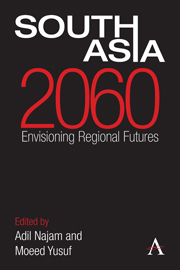Introduction: Imagining South Asian Futures
Published online by Cambridge University Press: 05 September 2013
Summary
Regions, by definition, are artificial constructs. South Asia is no exception. By all the attributes used to define regional groupings – geography, shared history, cultural, political and linguistic commonalities, cost effectiveness of economic interaction and even historical tensions originating from a shared past – South Asia is not just any region, but an ancient, well-established and important one. Yet, despite libraries devoted to the study of all things South Asian, there is relatively less intellectual effort to define the South Asian regional identity, practice as it pertains to the region and the long-term future of the region and its implications for the world.
Consisting of eight geographically proximate but extremely diverse states, the region is home to over one-fifth of the world's population – by 2060, it will be the world's most populated region; it sits atop a globally strategic location, watching over key sea lanes and offering the most attractive transit route to some of the richest energy reserves in Central Asia; the region is rife with conflict, and with nuclear weapons and global terrorism in the mix, its future has profound security implications for the rest of the world; and more recently, its economic potential attracted great positive attention, principally in the case of India but also for the region in general.
- Type
- Chapter
- Information
- South Asia 2060Envisioning Regional Futures, pp. 1 - 8Publisher: Anthem PressPrint publication year: 2013



